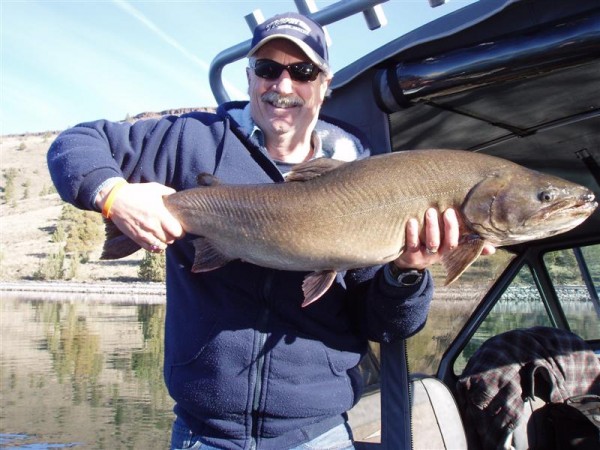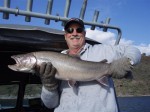My good buddy and outdoor writer, Joe Warren, sent me this article last week. It is an interesting read on the bull trout populations and cycles in Lake Bill Chinook.

Another shot of me holding Rick Coffin's killer 18 LB. bull. Congrats Rick!
Click to view image






Study Identifies Healthy Population Of ESA-Listed Bull Trout In Metolius River/Lake Billy Chinook
A recent study shows a dynamic and healthy population of bull trout spawning in Central Oregon's Metolius River tributaries, a population that moves back and forth between the river environment where they spawn and rear and Lake Billy Chinook.
Bull trout, listed as threatened under the federal Endangered Species Act in 1998, also have a predator-prey relationship with kokanee in the lake, their primary food source, resulting in a rise and fall in opposite years in populations of the trout and the kokanee.
At times, according to the study that was published online in the North American Journal of Fisheries Management this month, some spawning tributaries reach their carrying capacity for rearing bull trout, driving the most vulnerable fry into the lake to rear where a large percentage of the fish perish.
"This study is an analysis of data to look for relationships between the recruitment of bull trout in the Metolius (River) to the lake," said Portland General Electric's senior aquatic biologist Robert Spateholts. "And, indeed, there is a relationship between fry that travel to the lake and the number of redds in the tributaries. Fry don't survive well when they hit the lake, nearly representing a surplus in recruitment."
This indicates that the rearing habitat for bull trout in the tributaries is finite and, at times, "pretty well filled up," he added.
The study, "Recruitment of Young Bull Trout into the Metolius River and Lake Billy Chinook, Oregon," was published online November 7, 2015 (http://www.tandfonline.com/doi/abs/10.1080/02755947.2015.1074963?journalCode=ujfm20). Spateholts' co-authors are Don Ratliff, retired senior biologist; Megan Hill, fisheries supervisor; and Eric Schulz, retired data management specialist, all with PGE.
The specific relationships looked at by the authors were between bull trout spawning densities, emerging fry densities and the number of juveniles migrating into the reservoir in order to determine the potential role of juvenile production in the population decline.
"Metolius Bull Trout juveniles normally rear for extended periods within coldwater natal habitats," the study says. "In these habitats, successful fry must not only out-compete other fry, they must survive in close proximity to older, much larger, and potentially cannibalistic conspecifics."
As a result, the authors determined that "age-1 and older juvenile production is now limited by natal habitat capacity and that excess fry production is lost to density-dependent mortality," the study says.
What that probably means, according to Spateholts, is that as the fry hatch, those that emerge first find cover while the fry that emerge later must move downstream to escape the crowded conditions as well as escape cannibalism by the larger bull trout. Fry eventually move all the way into the lake.
"The amount of available habitat in the rearing tributaries determines what fish stay," he said. "The small or late bloomers migrate downstream looking for a place to rear."
Density-dependent mortality appears to be high in the Metolius River basin, the report says. The authors estimate fry emergence in the Metolius tributaries at 1 million to 2.5 million each year, but the average number of juveniles that reach the lake each year amounts to just 14,000. Mortality from the fry stage to the juvenile recruit stage can exceed 98 percent.
"The vast majority of this mortality probably occurs within the first few weeks after emergence as fry vie for food, cover, and rearing space while trying to avoid older Bull Trout and other predators," the report says.
During spawning surveys, the co-authors found, contrary to what is normally thought about impacts of fire on stream health, that spawning density was high after a recent fire. The Bear Butte and Booth forest fire complex, known as the B and B complex, appears to have increased the streams' complexity and productivity for bull trout spawning. According to the study, the fire burned both banks of nearly all of Jack, Canyon and Roaring creeks, 70 percent of Candle Creek and half of Jefferson Creek.
"The fire increased solar input and significantly increased the density and complexity of fire-induced woody structure within affected stream reaches," the study says. "We believe that the increased structural complexity in these natal habitat reaches has likely increased their rearing capacity for juvenile Bull Trout since the B and B Fire."
The higher solar input, according to Spateholts, may also have increased the abundance of invertebrates, a major food source for growing fish in streams.
There is a rise and fall of bull trout on the spawning grounds and in Lake Billy Chinook because of the very close relationship between bull trout and kokanee. As the bull trout population in the lake increases, kokanee, bull trout's primary food supply in the lake, declines. At some point, after a decline in the number of kokanee, the number of spawning age bull trout will decline.
The population of bull trout in the lake, a reservoir backed up behind Portland General Electric's Round Butte Dam, increased between 1998, when they were listed, through 2006, after a more restrictive fishery was introduced. Yet abundance has declined in recent years. In fact, bull trout abundance declined by 60 percent from 2006 to 2008, after a decline in the kokanee population in the lake.
Kokanee abundance peeked in 2000 but spawning kokanee declined significantly in 2004, peeked again in 2009, and went into a decline in 2013.
Pelton Dam and its re-regulating dam downstream were built in 1958. Round Butte Dam, the largest hydroelectric facility wholly within the state of Oregon, according to PGE, was added in 1964.
Also see:
-- CBB, Oct. 2. 2015, "USFWS Releases Final Bull Trout Recovery Plan; Past Legal Challengers Say Plan Still Deficient" http://www.cbbulletin.com/435132.aspx
From The Columbia Basin Bulletin at www.cbbulletin.com.

